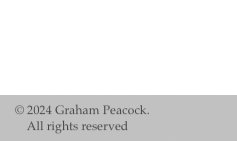|
A SPLASH: Peacock brightens his canvas
Judith Kellock, The Edmonton Sun (date unknown)
A Part of Graham Peacock's studio is dimly lit, silent save for the electric whirring of fans.
In long, narrow troughs lie lengths of canvas, deep in divided seas of rainbow paint.
The fans whir, the paint in the trough dries: It shrinks, pulls, tears and stretches into fissured skins over the canvas. It throws organic forms on the canvas into relief.
The paint colors keep their identities - partly through a judicious process of timed addition, determined by the artist's knowledge of acrylic paint's varying viscosities.
They swirl around and over objects cemented to the canvas; fossil forms of styrene gel; alligator ridges of thickly dried paint.
Hour by hour, the moisture leaves the paint in the troughs, as the tide retreats from a rocky pool. It leaves behind the painted surface, ready for cutting into panels, sometimes for revisions.
Stretched and framed, the results are resounding compositions in color, texture and shape. In places, the paint seems lit from within. Elsewhere, it darkens to nothing.
"It's like a topographical map, in which I'm building up a mountain range, coming out of Mediterranean," Peacock says.
Peacock adds a collage to the canvas before it goes into the trough. When the collage is dry, "the canvas is flooded."
But the flood is directed. "The pouring of the paint is the placement of the color. It's compositional," Peacock explains.
In fact, the entire process is directed. Before Peacock pours the paint, "I spend a few days considering color options, based on past experience; based on art, nature and pure blind luck."
After that, two days are spent mixing up to a 100 gallons of paint.
The result: "It's not one act that is rehearsed but rather a free-forming of a considered judgment based on past experience," Peacock says. "The intent is discovery, not finite execution. I set the stage to discover and explore a hypothesis."
Like any painter, he chooses the ground color first. "As I pour the under layers, I can control the shape or formation of the paint by the force and direction of the way I pour."
But don't grab a pail and start upending it. "This way is no easier than any other," the 42-year-old teacher of fine arts at the University of Alberta says. "It happens to suit my nature."
In the finished works, Peacock's sharp blues and audacious roses and golds don't flow together in a muddy lava. They remain sharply distinct.
Nor has he resorted to restricting his palette to avoid muddying of 'the colors. "My process of working doesn't involve agitating the painting together a great deal," Peacock says. "If I want the colors very intimate, then I will pour the colors through or on top of each other with a lot of force.
"The process is an integrated one: it physically mixes the paint with the surface and the color. I rely on the physical process of the paint, drying and shrinking."
"Size, surface, and color relationships and the inner shapes all have to be brought together in one voice. It's like an orchestra," Peacock says. " You have different temperaments of sound. For me, my canvas, the crustation effect of the gel and the paint skins are all different parts of my orchestra that I can use to make a complete sound."
Graham Peacock will be showing new works, some on paper, at Gallery on Whyte, November 18, at 7:30 p.m. through November 29.
|
|
|



